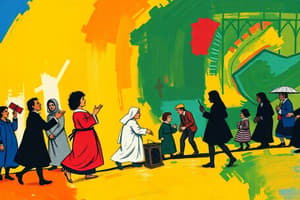Podcast
Questions and Answers
What was the primary impact of industrialization on women's careers?
What was the primary impact of industrialization on women's careers?
- Increased opportunities in factory work
- Complete equality in business and politics
- Encouraged women to participate in politics
- Decline of cottage industries limiting their roles (correct)
Premarital sex and adultery were viewed equally for both men and women.
Premarital sex and adultery were viewed equally for both men and women.
False (B)
Name the abolitionist newspaper founded by William Lloyd Garrison.
Name the abolitionist newspaper founded by William Lloyd Garrison.
The Liberator
The doctrine of ______ emphasized the separation of home life from business life.
The doctrine of ______ emphasized the separation of home life from business life.
Which of the following was NOT a belief of the New Abolition Movement in the 1830s?
Which of the following was NOT a belief of the New Abolition Movement in the 1830s?
Match the following abolitionist beliefs with their descriptions:
Match the following abolitionist beliefs with their descriptions:
Women were primarily viewed as nurturers and teachers of morality in society.
Women were primarily viewed as nurturers and teachers of morality in society.
What is one way that slavery created hardships for families according to abolitionist beliefs?
What is one way that slavery created hardships for families according to abolitionist beliefs?
What was a significant result of the Second Great Awakening?
What was a significant result of the Second Great Awakening?
Cane Ridge, Kentucky, was notable for attracting over 10,000 people to a religious camp meeting during the Second Great Awakening.
Cane Ridge, Kentucky, was notable for attracting over 10,000 people to a religious camp meeting during the Second Great Awakening.
What movement aimed to reduce alcohol consumption in America during the 19th century?
What movement aimed to reduce alcohol consumption in America during the 19th century?
By 1840, _____ of Americans were going to church.
By 1840, _____ of Americans were going to church.
Match the following groups with their roles during the Second Great Awakening:
Match the following groups with their roles during the Second Great Awakening:
What was one of the problems associated with alcohol consumption in the early 19th century?
What was one of the problems associated with alcohol consumption in the early 19th century?
The 'Cult of Domesticity' emphasized that women should not engage in household duties.
The 'Cult of Domesticity' emphasized that women should not engage in household duties.
What was a key characteristic of camp meetings during the Second Great Awakening?
What was a key characteristic of camp meetings during the Second Great Awakening?
Flashcards
Second Great Awakening
Second Great Awakening
A series of religious revivals that swept across the United States in the early 19th century.
Camp Meetings
Camp Meetings
Outdoor gatherings where preachers would minister to large crowds, lasting for days.
Simple Message of Salvation
Simple Message of Salvation
The belief that individuals could directly experience salvation through personal faith and commitment.
Temperance Movement
Temperance Movement
Signup and view all the flashcards
Cult of Domesticity
Cult of Domesticity
Signup and view all the flashcards
Alcohol Abuse
Alcohol Abuse
Signup and view all the flashcards
Evangelical Protestantism
Evangelical Protestantism
Signup and view all the flashcards
Growth of Religion
Growth of Religion
Signup and view all the flashcards
Women's Moral Superiority
Women's Moral Superiority
Signup and view all the flashcards
Doctrine of Separate Spheres
Doctrine of Separate Spheres
Signup and view all the flashcards
Women's Roles in the Home
Women's Roles in the Home
Signup and view all the flashcards
Sexual Double Standard
Sexual Double Standard
Signup and view all the flashcards
Early Abolitionism
Early Abolitionism
Signup and view all the flashcards
New Abolitionist Movement
New Abolitionist Movement
Signup and view all the flashcards
William Lloyd Garrison
William Lloyd Garrison
Signup and view all the flashcards
Arguments Against Slavery
Arguments Against Slavery
Signup and view all the flashcards
Study Notes
Revivalism and Reform
- Religious revivals swept the nation, particularly affecting Protestant denominations like Baptists and Methodists.
- Preachers traveled to rural areas, holding camp meetings.
- These meetings lasted for days, often attracting thousands, notably the one in Cane Ridge, Kentucky in 1801.
- Protestant revivals emphasized individual salvation, suggesting people from all walks of life could experience spiritual renewal.
- The Second Great Awakening boosted religious involvement, with a surge in evangelical Protestantism, specifically Baptists, Presbyterians, Congregationalists, and Methodists. Methodists in particular comprised a large portion of those attending church.
- By the mid-1840s, church attendance in America was high, exceeding half of the population.
Temperance Movement
- Americans consumed significantly more alcohol (7 gallons per adult per year) compared to modern times.
- Excessive drinking contributed to problems like abuse, poverty, and violence.
- The Temperance Movement emerged as a response.
- Pastors encouraged congregations to abstain from alcohol
- The movement advocated for abstinence from alcohol, led by organizations like the American Temperance Society and local temperance societies.
- By 1845, alcohol consumption in America was significantly reduced.
Family Life
- The "Cult of Domesticity" described a dominant view where women were responsible for the household and childcare, acting as primary care givers.
Studying That Suits You
Use AI to generate personalized quizzes and flashcards to suit your learning preferences.




